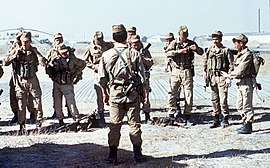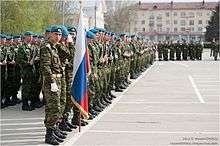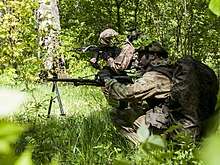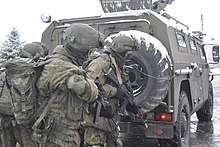Special Forces of the Main Directorate of the General Staff of the Russian Armed Forces
| Special Forces of the Main Directorate of the General Staff of the Russian Armed Forces | |
|---|---|
 | |
| Active | 1949–2012, 2013–present |
| Country |
1991–2010 (under the GRU) 2010–2012 (Non-GRU) 2013–present (under the GRU) |
| Branch |
|
| Type | Special forces (spetsnaz) |
| Role |
Special reconnaissance Direct action |
| Size | Classified[1] |
| Part of |
(1949–1991) (1991–present) |
| GRU Headquarters | 76 Khoroshyovskoe shosse, Khodinka, Moscow |
| Mascot(s) | Bat |
| Engagements |
Cold War conflicts Soviet–Afghan War Civil War in Tajikistan East Prigorodny conflict War in Abkhazia First Chechen War Invasion of Dagestan Second Chechen War Insurgency in the North Caucasus Russo-Georgian War Syrian Civil War Russian military intervention in the Syrian Civil War |
| Commanders | |
| Current commander | Colonel Blazhko Anatoliy Andreevich |
| Notable commanders | Colonel Sidorov Gennadiy Konstantinovich |
Special Forces of the Main Directorate of the General Staff of the Russian Armed Forces (Russian: Части и подразделения специального назначения (спецназ) Главного управления Генерального штаба Вооружённых сил Российской Федерации (СпН ГУ ГШ ВС РФ)), commonly known as the Spetsnaz GRU, is the special forces (spetsnaz) of the GRU, the foreign military intelligence agency of the Armed Forces of the Russian Federation.
The Spetsnaz GRU was formed in 1949, the first spetsnaz force in the Soviet Union, as the military force of the Main Intelligence Directorate (GRU), the foreign military intelligence agency of the Soviet Armed Forces. The force was designed in the context of the Cold War to carry out reconnaissance and sabotage against enemy targets in the form of special reconnaissance and direct action attacks. The Spetsnaz GRU inspired additional spetsnaz forces attached to other Soviet intelligence agencies, such as the Vympel and Alpha Group of the KGB.
Following the dissolution of the Soviet Union in 1991, the Spetsnaz GRU remained intact until 2010, when it was reassigned to the Ground Forces.[2] In 2013, the Special Operations Forces of the General Staff were established.
History
Soviet era

The concept of using special forces tactics and strategies in the Soviet Union was originally proposed by the military theorist Mikhail Svechnykov, who envisaged the development of unconventional warfare capabilities in order to overcome disadvantages that conventional forces may face in the field. Svechnykov was executed during the Great Purge in 1938, but practical implementation of his ideas was begun by Ilya Starinov, dubbed the "grandfather of the spetsnaz". Following the entrance of the Soviet Union into World War II, basic forces dedicated to acts of reconnaissance and sabotage were formed under the supervision of the Second Department of the General Staff of the Soviet Armed Forces, and were subordinate to the commanders of Fronts.[3]
The situation was reviewed after the war ended, and between 1947 and 1950 the whole of the Main Intelligence Directorate (GRU) was reorganized.[4] The first "independent reconnaissance companies of special purpose" were formed in 1949, to work for tank and combined-arms armies, which were tasked to eliminate amongst others enemy nuclear weapons systems such as the MGR-3 Little John and MGM-1 Matador.[4] In 1957, the first Spetsnaz battalions were formed under the GRU, five to operate beyond the 150–200 km range of the reconnaissance companies. The first brigades were formed in 1962, reportedly to reach up to 750 kilometres in the rear to destroy U.S. weapons systems such as the MGM-52 Lance, MGM-29 Sergeant, and MGM-31 Pershing.[4] Two 'study regiments' were established in the 1960s to train specialists and NCOs, the first in 1968 at Pechora near Pskov, and the second in 1970 at Chirchik near Tashkent.[5] According to Vladimir Rezun, a GRU defector who used the pseudonym "Viktor Suvorov", there were 20 GRU Spetsnaz brigades plus 41 separate companies at the time of his defection in 1978.
The primary function of Spetsnaz troops in wartime was infiltration/insertion behind enemy lines (either in uniform or civilian clothing), usually well before hostilities are scheduled to begin and, once in place, to commit acts of sabotage such as the destruction of vital communications logistics centers, and the possible assassination of key government leaders and military officers. Spetsnaz GRU operatives would have to complete training that included the following: weapons handling, rappelling, explosives training, marksmanship, counter-terrorism, airborne training, hand-to-hand combat, climbing (alpine rope techniques), diving, underwater combat, long-range marksmanship, emergency medical training, and demolition.
In 1979, Spetsnaz GRU participated in Operation Storm-333, the successful mission to kill Hafizullah Amin, the President of Afghanistan, and triggering the Soviet–Afghan War.
Russian Federation era

In 2003, during the Second Chechen War, the GRU formed the Special Battalions Vostok and Zapad, two ethnic Chechen units that belonged to the Spetsnaz GRU that fought primarily in Chechnya, but also in the 2008 Russo-Georgian War as well as peacekeeping operations after the 2006 Lebanon War. The controversial battalions were eventually disbanded in November 2008.
In 2009, a Directorate of Special Operations was established following a study of Western special operations forces units and commands with Special Operations Forces raised that reported directly to the General Staff bypassing the GRU.[6][7] In 2013, the Directorate became the Special Operations Command with a GRU unit transferring to the Command.[7]
In 2010, Spetsnaz GRU forces were attached to the military districts of the Ground Forces and subordinated to the operational-strategic commands, due to Anatoliy Serdyukov's military reforms.[2][7] This decision was reversed in 2013.[7] By early 2017 it was being reported that Serdyukov's reform had been almost entirely reversed to the pre-2010 status quo.
In 2015, GRU special forces soldiers were reportedly involved in the Syrian Civil War, appearing in Aleppo and Homs.[8][9] GRU officials have also visited Qamishli, near the border with Turkey.[10]
Listing of brigades
Below is a list of current "Spetsnaz" units in the Russian Armed Forces that fall under GRU operational control:[11][12][13]
- Russian Ground Forces[14][15] - fields 8 spetsnaz brigades of varying sizes and one spetsnaz regiment (25th).
- 2nd Spetsnaz Brigade – based in Promezhitsa, Pskov Oblast
- Brigade HQ
- Signals Battalion (2× Company)
- Support Company
- 70th Special Purpose Detachment
- 329th Special Purpose Detachment
- 700th Special Purpose Detachment
- Training Battalion (2× Company)
- Brigade HQ
- 3rd Special Purpose Brigade – based in Tolyatti
 3rd Spetsnaz Brigade on parade, 9 May 2011.
3rd Spetsnaz Brigade on parade, 9 May 2011.- Brigade HQ
- Signals Company
- Special Weapons Company
- Support Company
- Logistics Company
- 509th Special Purpose Detachment
- 510th Special Purpose Detachment
- 512th Special Purpose Detachment
- 330th Special Purpose Detachment
- 501st Special Purpose Detachment
- 503rd Special Purpose Detachment
- Training Battalion (2× Company)
- Brigade HQ
- 10th Special Purpose Brigade – based in Mol'kino, Krasnoyarsk Territory
- Brigade HQ
- Signals Company
- Special Weapons Company
- Support Company
- Logistics Company
- K-9 Unit
- 325th Special Purpose Detachment
- 328th Special Purpose Detachment
- Training Battalion (2× Company)
- Brigade HQ
- 14th Special Purpose Brigade – based in Ussuriysk
- Brigade HQ
- Signals Company
- Logistics Company
- 282nd Special Purpose Detachment
- 294th Special Purpose Detachment
- 308th Special Purpose Detachment
- Training Battalion (2× Company)
- Brigade HQ
- 16th Special Purpose Brigade – based in Tambov, with all units deployed in Tambov except for the 664th SPD.[16]
 370th SPD conducting special reconnaissance training (2017).
370th SPD conducting special reconnaissance training (2017).- Brigade HQ
- EOD company
- Signals Company
- Logistics Company
- 370th Special Purpose Detachment
- 379th Special Purpose Detachment
- 585th Special Purpose Detachment
- 664th Special Purpose Detachment
- 669th Special Purpose Detachment
- Brigade HQ
- 22nd Special Purpose Brigade – entire unit is based in Stepnoi, Rostov Oblast[17][18]
 22nd SPB operatives conducting winter Anti-Terrorist training (2017).
22nd SPB operatives conducting winter Anti-Terrorist training (2017).- Brigade HQ
- Signals Company
- Support Company
- Special Weapons Company
- Logistics Unit
- Engineer Unit
- 108th Special Purpose Detachment
- 173rd Special Purpose Detachment
- 305th Special Purpose Detachment
- 411th Special Purpose Detachment
- Brigade HQ
- 24th Special Purpose Brigade – based in Irkutsk, with all units and units deployed in Irkutsk[16]
- Brigade HQ
- Signals Company
- Special Weapons Company
- Logistics Unit
- 281st Special Purpose Detachment
- 297th Special Purpose Detachment
- 641th Special Purpose Detachment
- Brigade HQ
- 346th Special Purpose Brigade in Prokhladny
- 25th Special Purpose Regiment
- 2nd Spetsnaz Brigade – based in Promezhitsa, Pskov Oblast
- Russian Airborne Troops[19]
- Naval Special Reconnaissance (OMRP)[20] – Reconnaissance divers under operational subordination to the Main Intelligence Directorate (GRU).
- 42nd Marine Reconnaissance point (Pacific Fleet)
- 388th Marine Reconnaissance point (Black Sea Fleet) – reorganized from the former 431st MRP
- 420th Marine Reconnaissance point (Northern Fleet)
- 561st Marine Reconnaissance point (Baltic Fleet)
References
- ↑ Spionage gegen Deutschland — Aktuelle Entwicklungen Stand: November 2008 (in German)
- 1 2 McDermott, Roger (2 November 2010). "Bat or Mouse? The Strange Case of Reforming Spetsnaz". Jamestown.org. Retrieved 2014-08-19.
- ↑ Carey Schofield, The Russian Elite: Inside Spetsnaz and the Airborne Forces, Greenhill, London, 1993, p.34
- 1 2 3 Carey Schofield, The Russian Elite: Inside Spetsnaz and the Airborne Forces, Greenhill, London, 1993, p.35
- ↑ Carey Schofield, The Russian Elite: Inside Spetsnaz and the Airborne Forces, Greenhill, London, 1993, p.37
- ↑ Marsh, Dr. Christopher (2017). Developments in Russian Special Operations - Russia's Spetsnaz, SOF and Special Operations Forces Command (PDF). CANSOFCOM Education & Research Centre Monograph Series. Ottawa, Ontario: Canadian Special Operations Forces Command. ISBN 9780660073538. Retrieved 22 September 2017.
- 1 2 3 4 Nikolsky, Alexey (2015). "Little, Green and Polite: The Creation of Russian Special Operations Forces". In Howard, Colby; Pukhov, Ruslan. Brothers Armed: Military Aspects of the Crisis in Ukraine (2nd ed.). Minneapolis: East View Press. ISBN 9781879944657.
- ↑ Tsvetkova, Maria (November 5, 2015). "New photos suggest Russia's operation in Syria stretches well beyond its air campaign". Business Insider. Archived from the original on December 30, 2016.
CIT also published screenshots from the Instagram page of Ilya Gorelykh, who it said had served in Russia's GRU special forces in the past [...] In late October it showed he had uploaded pictures from Aleppo, one of which showed him holding an assault rifle while wearing civilian clothes. Another image of him posing in camouflage with three other armed men was apparently taken in Homs.
- ↑ "Beyond the airstrikes: Russia's activities on the ground in Syria". November 8, 2015. Archived from the original on December 30, 2016.
We believe that Russia's operation in Syria is a "hybrid war", not unlike the one seen in Ukraine. Apart from the airstrikes, Russia provides Assad forces with surface-to-surface rocket systems, combat vehicles, equipment, advisors, artillery support and spotters. More importantly, recently there have been more and more reports of Russian soldiers, vehicles and "volunteers" being spotted close to the frontlines.
- ↑ Agence France-Presse (January 22, 2016). "Turkey alarmed by 'Russian build-up' on Syria border". The National. Archived from the original on December 30, 2016.
Top Russian military officials, including figures from the GRU military intelligence service, had already visited Qamishli, it added.
- ↑ ГРУ (Главное Разведывательное Управление) ГШ ВС РФ. Russian Military Analysis (in Russian). Retrieved December 30, 2012.
- ↑ Военно-Морской Флот. Russian Military Analysis (in Russian). Retrieved December 31, 2012.
- ↑ Security, Global. "Spetsnaz Order of Battle". GlobalSecurity.org. Retrieved 27 April 2017.
- ↑ John Pike. "Spetsnaz Order of Battle". Retrieved 31 July 2015.
- ↑ http://vdvloknya.ucoz.ru/news/1_dekabrja_den_rozhdenija_2_obr_specnaz_gru/2012-11-30-776
- 1 2 Сергей Козлов. Спецназ ГРУ: Очерки истории. // Том 5. Новейшая история. 1999-2010 гг.. — Москва: Русская панорама, 2010. — P. 40–41, 44–50, 65, 335–336, 492–493. — 400 p. — 3 000 экз.
- ↑ 22 гв ОБрСпН — первая в Российской Гвардии
- ↑ 22 гвардейская отдельная бригада специального назначения (22 огбрСпН ГРУ)
- ↑ John Pike. "45th Special Purpose Regiment". Retrieved 31 July 2015.
- ↑ John Pike. "Naval Spetsnaz [Spetsialnaya Razvedka]". Retrieved 31 July 2015.
Further reading
| Wikimedia Commons has media related to Special Forces of the Main Directorate of the General Staff of the Russian Armed Forces. |
- Carey Schofield, The Russian Elite: Inside Spetsnaz and the Airborne Forces, Greenhill, London, 1993
- Scott and Scott, The Armed Forces of the Soviet Union
- Viktor Suvorov, Spetsnaz: The Story Behind the Soviet SAS, 1987, Hamish Hamilton Ltd, ISBN 0-241-11961-8
- Steve Zaloga, James W. Loop, Soviet Bloc Elite Forces, Volume 5 of Elite Series, Osprey Publishing, 1985, ISBN 0850456312, 9780850456318
.svg.png)